Quick Links
About Model Portfolios
Our approach to portfolio management is a blend of art and science. Past performance can be useful, but just picking the funds that performed best in the past is typically not a good way to build a portfolio for the future. Our model portfolios reflect a well thought out and disciplined approach to both asset allocation and fund selection.
We generally build private client investment portfolios using traditional open-end mutual funds and exchange traded funds (ETFs). Our portfolio construction process places an emphasis on keeping fees low, finding long-tenured managers, and identifying funds who have performed well in their category and have consistent risk-adjusted returns.
Matisse Capital offers 5 model portfolio types, each model:
- Aids in the effective and prudent management of client investment portfolios
- Fits one of five different client risk profiles
- Client risk profiles are in part determined through Matisse’s custom questionnaire
- Questionnaire is completed during client onboarding
- Model suitability for each client is determined after completing the questionnaire
- Acts as a starting point in building and managing custom client portfolios
- No two clients are the same – but portfolios may look and feel similar
- We ultimately manage each client’s portfolio individually, while considering tax and liquidity requirements
- Global recommendations and changes are not always appropriate, and are assessed individually for each client
Model Portfolio Comparison
| Model Portfolio | Investment Objective* | % Equity / % Fixed | Style of Investments Used |
|---|---|---|---|
| I. Equity | Maximize long-term total return | 100% Equity | Growth |
| II. Equity Tilted Balanced | Maximize long-term total return while minimizing the frequency and magnitude of a 12-month decline in portfolio value greater than 15% | 75% Equity / 25% Fixed | Growth and Income, with a primary emphasis on Growth |
| III. Balanced | Maximize long-term total return while minimizing the frequency and magnitude of a 12-month decline in portfolio value greater than 10% | 60% Equity / 40% Fixed | Growth and Income, with a slight emphasis on Growth |
| IV. Conservative Balanced | Maximize long-term total return while minimizing the frequency and magnitude of a 12-month decline in portfolio value greater than 5% | 40% Equity / 60% Fixed | Growth and Income, with a slight emphasis on Income |
| V. Defensive Balanced | Maximize long-term total return while minimizing the frequency and magnitude of a 12-month decline in portfolio value greater than 2.5% | 20% Equity / 80% Fixed | Growth and Income, with a primary emphasis on Income |
*Declines greater than the Model Portfolio’s stated investment objective can occur during periods of high volatility, such as an extreme bear market.
I. Equity Model Portfolio 100% Equity / 0% Fixed Income
The Equity Model is a fully invested, global stock portfolio.
- The ups and downs of the portfolio’s returns will be as wide as the equity market’s
- Along with higher risk, we expect higher long-term returns than what are available from our other, less aggressive models
- Appropriate for investors with a long time horizon and no concerns about short-term risk
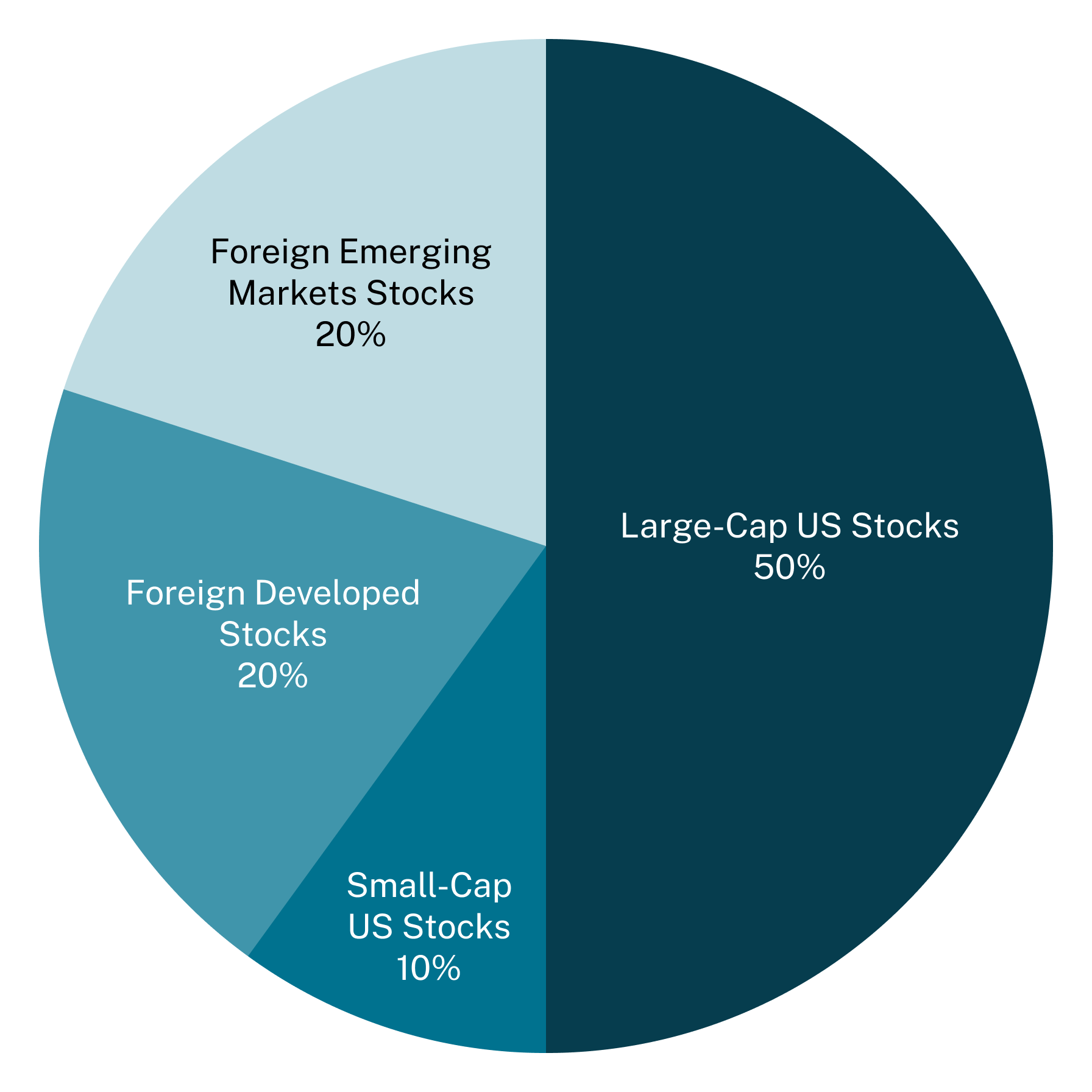
The Equity Model strategic portfolio allocation is a 100% stock portfolio represented by broad asset class indexes as weighted below:
| Asset Class | Index | Strategic Portfolio Allocation |
|---|---|---|
| Investment Grade Bonds | Bloomberg Barclays U.S Aggregate Bond Index | 0% |
| Large-Cap US Stocks | S&P 500 Index | 50% |
| Small-Cap US Stocks | Russell 2000 Index | 10% |
| Foreign Developed Stocks | MSCI EAFE Index | 20% |
| Foreign Emerging Markets Stocks | MSCI Emerging Markets Index | 20% |
II. Equity Tilted Balanced Model Portfolio 75% Equity / 25% Fixed Income
The Equity Tilted Balanced Model is managed in an effort to limit the maximum loss in a 12-month period to no more than 15%
- We cannot guarantee that this threshold won't be exceeded
- This model has a more aggressive 75% default allocation to equities
- Appropriate for investors who are willing to accept higher short-term risk in exchange for the likelihood of higher long-term returns than what are available from our more conservative portfolios
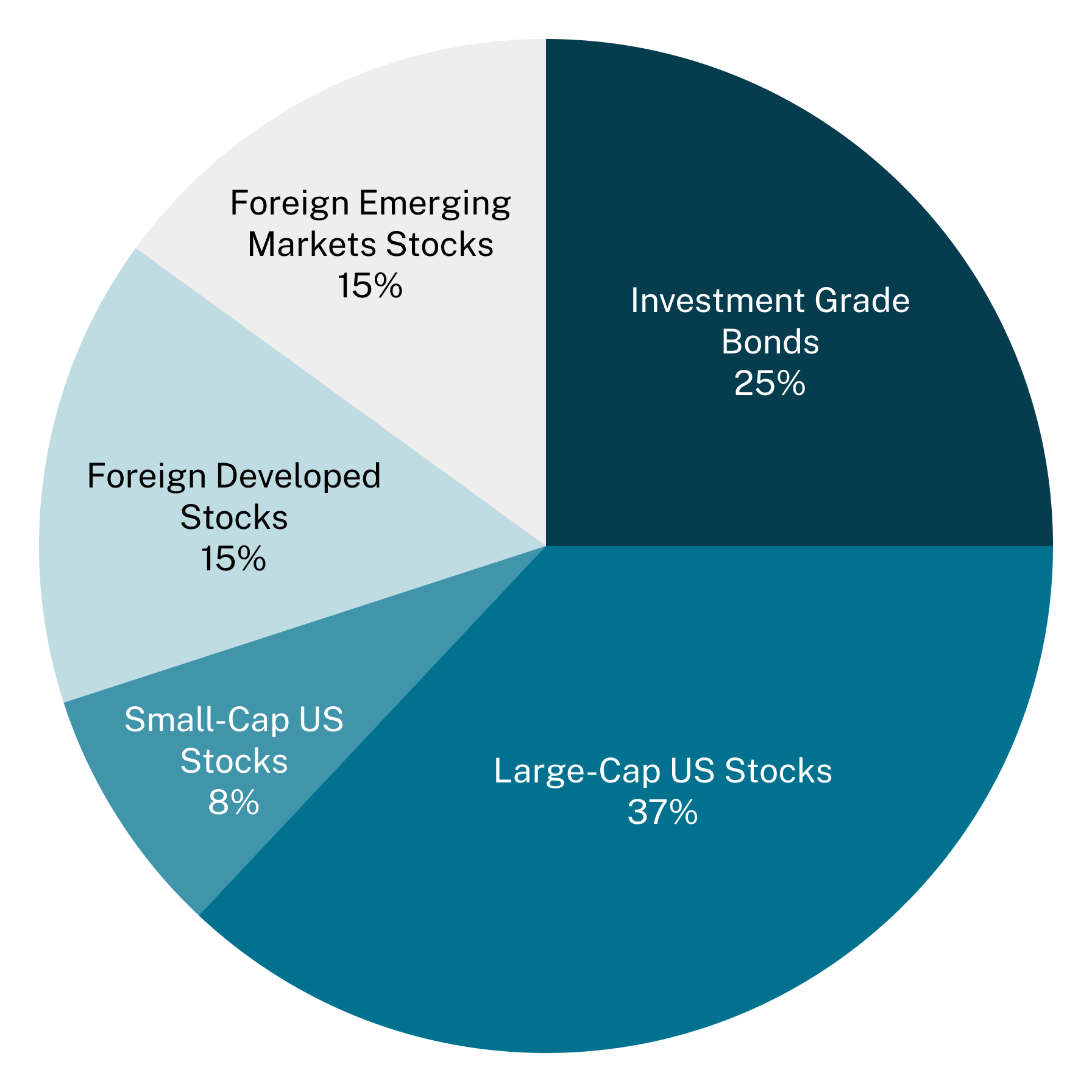
The Equity Tilted Balanced Model strategic portfolio allocation is a blend of 75% stocks and 25% bonds represented by broad asset class indexes as weighted below:
| Asset Class | Index | Strategic Portfolio Allocation |
|---|---|---|
| Investment Grade Bonds | Bloomberg Barclays U.S Aggregate Bond Index | 25% |
| Large-Cap US Stocks | S&P 500 Index | 37% |
| Small-Cap US Stocks | Russell 2000 Index | 8% |
| Foreign Developed Stocks | MSCI EAFE Index | 15% |
| Foreign Emerging Markets Stocks | MSCI Emerging Markets Index | 15% |
III. Balanced Model Portfolio 60% Equity / 40% Fixed Income
The Balanced Model is managed in an effort to limit the maximum loss in a 12-month period to no more than 10%
- We cannot guarantee that this threshold won't be exceeded
- The higher downside risk threshold allows us to have more equity exposure than in our conservative balanced portfolio, while remaining relatively conservative
- Appropriate for investors who want to participate in the equity markets but are still somewhat uncomfortable with short-term risk
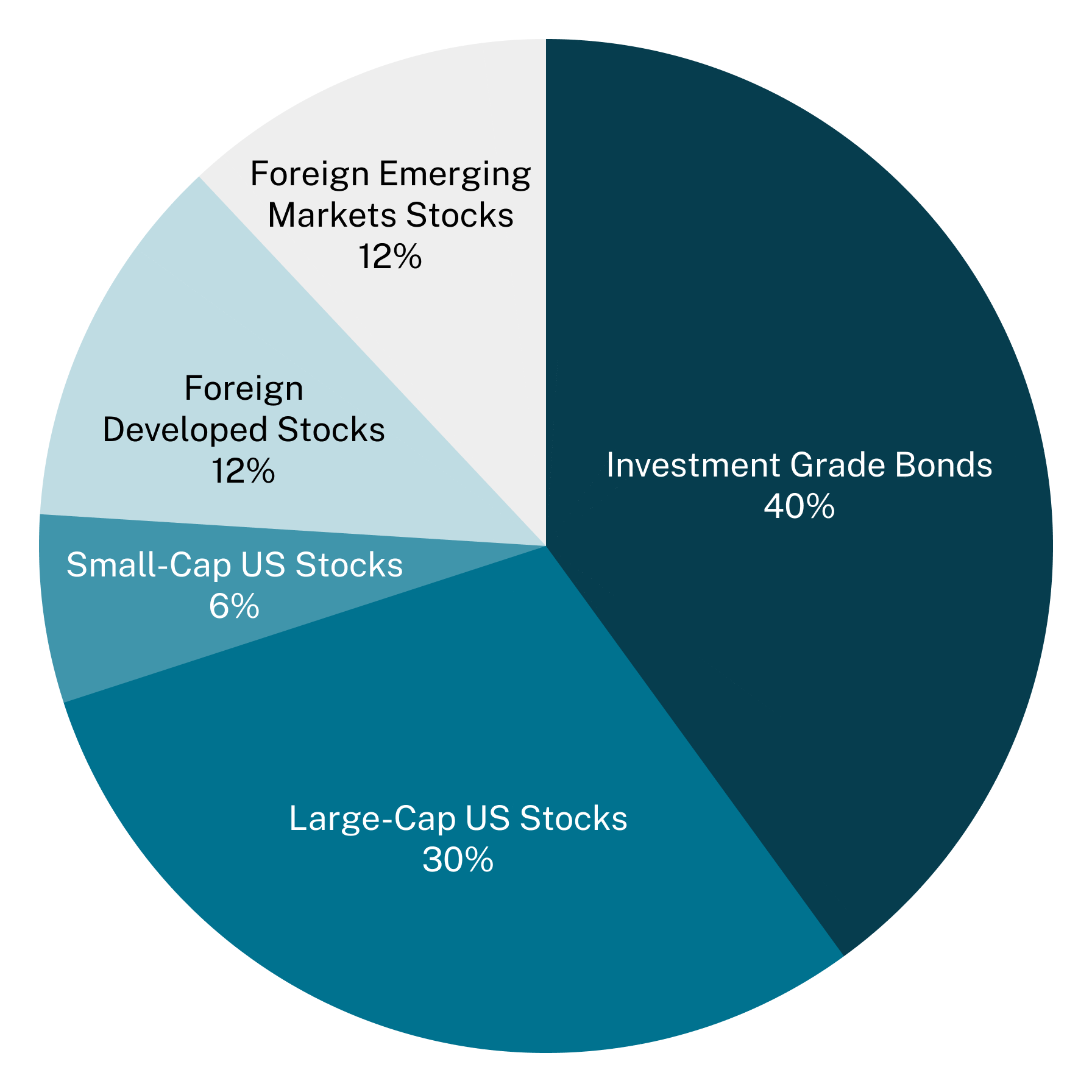
The Balanced Model strategic portfolio allocation is a blend of 60% stocks and 40% bonds represented by broad asset class indexes as weighted below:
| Asset Class | Index | Strategic Portfolio Allocation |
|---|---|---|
| Investment Grade Bonds | Bloomberg Barclays U.S Aggregate Bond Index | 40% |
| Large-Cap US Stocks | S&P 500 Index | 30% |
| Small-Cap US Stocks | Russell 2000 Index | 6% |
| Foreign Developed Stocks | MSCI EAFE Index | 12% |
| Foreign Emerging Markets Stocks | MSCI Emerging Markets Index | 12% |
IV. Conservative Balanced Model Portfolio 40% Equity / 60% Fixed Income
The Balanced Model is managed in an effort to limit a maximum loss in a 12-month period to no more than 5%
- We cannot guarantee that this threshold won't be exceeded
- Our default allocation to equities in this model is 40%, with 60% in fixed-income
- Appropriate for investors who are uncomfortable with higher short-term risk and who value short-term capital preservation over higher long-term returns
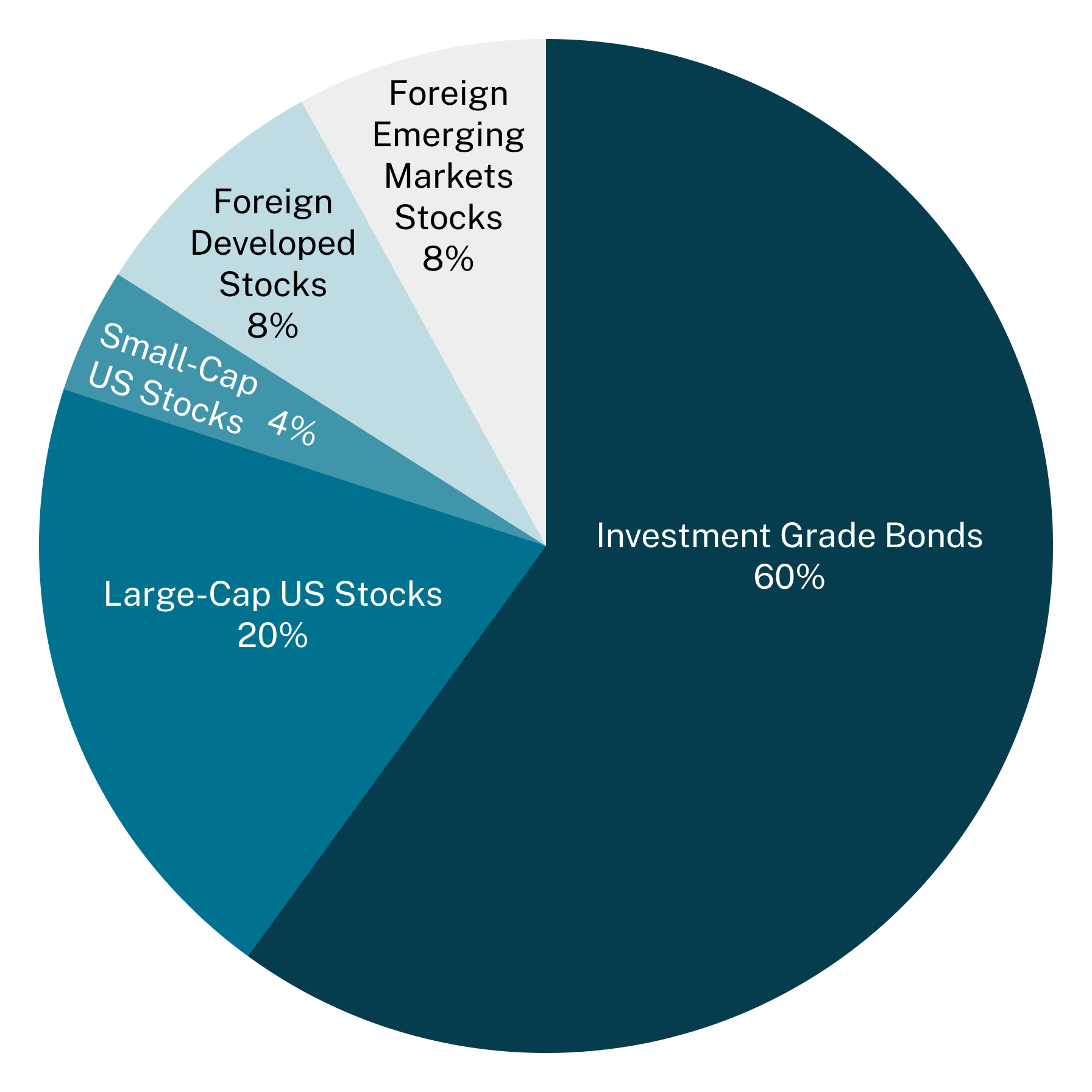
The Conservative Balanced Model strategic portfolio allocation is a blend of 40% stocks and 60% bonds represented by broad asset class indexes as weighted below:
| Asset Class | Index | Strategic Allocation |
|---|---|---|
| Investment Grade Bonds | Bloomberg Barclays U.S Aggregate Bond Index | 60% |
| Large-Cap US Stocks | S&P 500 Index | 20% |
| Small-Cap US Stocks | Russell 2000 Index | 4% |
| Foreign Developed Stocks | MSCI EAFE Index | 8% |
| Foreign Emerging Markets Stocks | MSCI Emerging Markets Index | 8% |
V. Defensive Balanced Model Portfolio 20% Equity / 80% Fixed Income
The Defensive Balanced Model is managed in an effort to limit a maximum loss in a 12-month period to no more than 2.5%
- We cannot guarantee that this threshold won't be exceeded
- Our default allocation to equities in this model is 20%, with 80% in fixed-income
- Appropriate for investors who have very short time horizons and who value short-term capital preservation over higher long-term returns
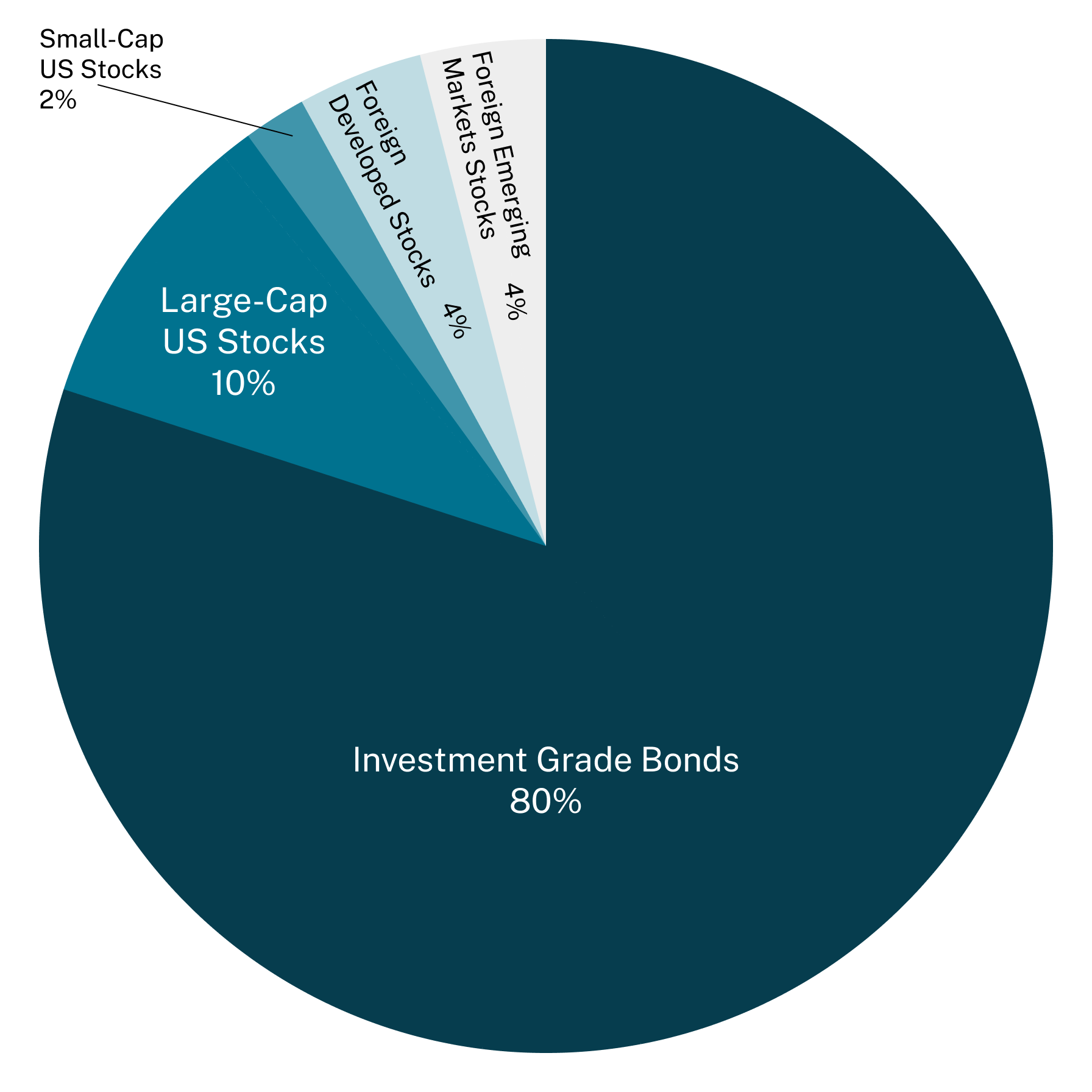
The Defensive Balanced Model strategic portfolio allocation is a blend of 20% stocks and 80% bonds represented by broad asset class indexes as weighted below:
| Asset Class | Index | Strategic Allocation |
|---|---|---|
| Investment Grade Bonds | Bloomberg Barclays U.S Aggregate Bond Index | 80% |
| Large-Cap US Stocks | S&P 500 Index | 10% |
| Small-Cap US Stocks | Russell 2000 Index | 2% |
| Foreign Developed Stocks | MSCI EAFE Index | 4% |
| Foreign Emerging Markets Stocks | MSCI Emerging Markets Index | 4% |
Risk Management
| Equity | Equity Tilted Balanced | Balanced | Conservative Balanced | Defensive Balanced | |
|---|---|---|---|---|---|
| 12-Month Target Maximum Downside Loss Threshold* | Equity-Like Risk | 15% | 10% | 5% | 2.5% |
*Declines greater than the Model Portfolio’s stated loss threshold can occur during periods of high volatility, such as an extreme bear market.
We attempt to minimize the frequency and magnitude of a 12-month decline in portfolio value in excess of each model’s stated loss threshold. Although this is the stated goal of our risk management strategy, declines in excess of each model’s stated loss threshold can occur during periods of high volatility, such as an extreme bear market.
In general, we don't attempt to manage each portfolio so as to avoid violating our loss thresholds in very extreme negative environments. We believe they are rare and would require an allocation so permanently conservative that we believe it would cost more capital over the long run. So while our objective is not to exceed our risk threshold targets in the vast majority of environments, there is no guarantee that we will do so. Each investor should carefully consider their portfolio strategy in light of their risk tolerance and the possibility that losses could exceed our target levels.
Model Portfolio Disclosures
An index is a portfolio of specific securities, the performance of which is often used as a benchmark in judging the relative performance of certain asset classes. Indexes are unmanaged portfolios and investors cannot invest directly in an index. An index does not charge management fees or brokerage expenses.
This is prepared for informational purposes only. It does not address specific investment objectives, or the financial situation and the particular needs of any person who may receive this information. The models are subject to a number of limitations, and do not reflect the results of any actual Matisse client accounts, which may be materially different to those of the models. The performance of an actual client account will likely vary from Matisse’s investment models for several reasons, including custodial costs and other fees, actual transaction costs in a client account being higher or lower than the model transaction costs, market conditions during trading, investment selection availability, and/or other factors.
Model returns do not reflect actual trading and may not reflect the impact that material economic and market factors may have had on the advisor’s decision-making had the advisor managed client’s funds. Client’s investment results may differ materially from the results portrayed in the model. Representation of securities or models presented in this piece does not guarantee the current or future use of such models or securities by Matisse Capital.
The Bloomberg Barclays U.S Aggregate Bond Index measures the performance of investment grade, U.S. dollar-denominated, fixed-rate taxable bond market, including Treasuries, government-related and corporate securities, MBS (agency fixed-rate and hybrid ARM passthroughs), ABS, and CMBS.
The S&P 500 Index is a market-capitalization-weighted index of the 500 largest U.S. publicly traded companies.
The Russell 2000 Index measures the performance of the small-cap segment of the U.S. equity universe.
The MSCI EAFE Index measures the performance of the large and mid-cap segments of developed markets, excluding the US & Canada equity securities. It is free float-adjusted market-capitalization weighted.
The MSCI Emerging Markets Index is a selection of stocks that is designed to track the financial performance of key companies in fast-growing nations, capturing large and mid cap representation across Emerging Markets countries. The index covers approximately 85% of the free float-adjusted market capitalization in each country.
